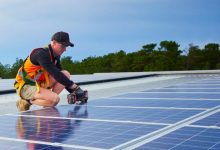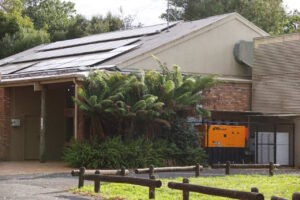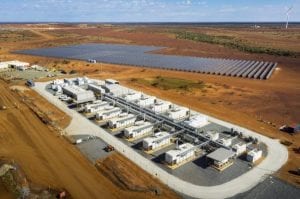The runway to Australia’s 2030 renewable energy target is starting to look difficult, but taking a coordinated approach to rooftop solar could solve that particular problem, says a new report.
The federal target of 82 per cent renewables in the National Electricity Market (NEM) by 2030 is not legislated nor are there any policy mechanisms in place to get there – but it requires at least 6 gigawatts of new capacity to be installed every year to get there.
With rooftop solar still powering ahead, the government could reach its target by properly backing this segment of renewables by creating a National Distributed Energy Resources (DER) Policy and Coordination Office, says a report from Nexa Advisory.
That office could bring together the current piecemeal attempts by states and companies to manage the huge number of Australians who are now part of a powerful generating asset in their own right.
“Australia’s clean energy transition has stalled,” says Nexa Advisory CEO and founder Stephanie Bashir.
“Despite the influx of new funds under programs like Rewiring the Nation, we are struggling to build new large renewable generation and batteries and the new transmission to connect that clean generation to customers.
“Vested interests and lack of effective community engagement are political and practical dead weights to progress.
“The solution is to give the “power to the people”. Australians love rooftop solar. They love the cost of living impact, they love the climate impact, and they love the control over their own costs and assets.
“DER is Australia’s secret weapon in transition – it is what will make us a clean energy superpower. And governments can enable it now, with a coordinated national strategy that focuses on removing barriers to DER take-up by households and businesses.”
Rooftop solar is already reshaping the grid with an installed capacity that makes up 25 per cent of the grid, according to the Clean Energy Council.
However, that capacity is eating deeply into market share, as rooftop now regularly feeds almost half of demand on the NEM during the midday generation peaks, and in South Australia in September it was meeting all demand on one Saturday afternoon.
In 2022, almost half of the 6 GW renewables install required to hit the 2030 target came not from large scale generators or storage, but rooftop solar, with 2.7 GW added. This year is headed to at leat 3GW.
Another call for DER to be taken seriously
Bashir’s report outlines five demands to bring rooftop into the national grid in a real and coordinated way, with number one being the new federal body.
That office could direct innovations around distribution network tariff design that adopts a ‘flexibility first’ approach which prompts Distributed Network Service Providers (DNSPs) to look at existing rooftop capacity before building new poles and wires.
It also needs to review the rule change that allows DNSPs to charge an export tariff.
Recommendation three demands support for low-income earners and renters, who are currently locked out of rooftop solar benefits, while number four calls for the opening up of network operations data, to make information on where new infrastructure, such as a community battery, is needed as opposed to DNSPs controlling that data.
The fifth idea is take network voltage standards out of state regulators’ hands and impose a national 230V voltage standard, so DNSPs must stop operating their networks at a higher standard that’s also closer to the upper limit.
“If networks operated at 230 V, then there would be a lot more ‘headroom’ for solar PV generation and increased capacity in the networks to host more rooftop solar PV,” Bashir and co-author Dr Jill Cainey wrote.
Pathway marred by distrust and slowness
Australia will need 79 GW of renewables – 35 GW of rooftop solar PV and 44 GW of large-scale wind and solar generation – to meet its 2030 goal, under the step change scenario in the Australian Energy Market Operator (AEMO)’s 2022 Integrated System Plan (ISP).
As of 2022, Australia had 21 GW of rooftop solar and 25 GW of large-scale renewable generation.
“The transmission build that will be required… is the equivalent of 25 per cent of today’s entire grid. It will now need to be built in less than 7 years,” write Bashir and Cainey.
“As such, development of transmission has been identified as a potential bottleneck to new renewable generation capacity.”
Furthermore, dense regulatory landscapes, slow state approval processes like in NSW, cost issues and basic logistics – it takes months to get giant wind turbines to inland locations – are slowing down the large scale side of renewables.
DER is the only renewable sector to achieve the growth rates needed under the ISP to hit the 2030 target, Australia is a global leader in technological advancements, and rooftops on the commercial and industrial sector are an untapped resource, Bashir and Cainey say.
However, there are also significant barriers to making full use of DER.
Australians don’t trust DNSPs, and certainly not enough to hand over control of an expensive personal investment – research shows they’re investing in rooftop solar to protect themselves from large companies, not to cooperate.
“There is little financial benefit for a customer that has invested in DER to provide support services to the system… Currently, DER is forced to compete in the wholesale market, with complex and costly technical compliance requirements,” the report says.
“In order to get better value for DER owners and the power system, customer flexibility through demand response needs to be accommodated into the design of the National Electricity Market.”
See also: Solar switch-off a must for all states, says AEMO, to control “seven Erarings” of rooftop PV










